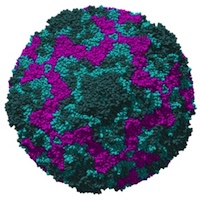Prevalence of non-polio enteroviruses infections among children in Northern Nigeria

Accepted: 11 September 2020
All claims expressed in this article are solely those of the authors and do not necessarily represent those of their affiliated organizations, or those of the publisher, the editors and the reviewers. Any product that may be evaluated in this article or claim that may be made by its manufacturer is not guaranteed or endorsed by the publisher.
Authors
Background: Human non-polio enteroviruses (NPEVs) have been associated with certain life-threatening disorders in children. However, there is paucity of NPEV infection data in most developing countries. This study determined the 3-year prevalence of non-polio enteroviruses (NPEVs) among children in some Northern States of Nigeria.
Materials and Methods: Duplicate stool samples were collected from 27778 children ≤15 years. These samples were processed and analyzed for characteristic NPEVs cytopathic effects (CPE) on L20B and RD cell lines. Tests were considered positive if the duplicate samples produced distinct CPE on both cell lines.
Results: Of the 27778 samples processed, 3991 (14.4%) NPEVs were isolated. Participants of the male gender (14.5%) within the age range of 0-5 years (14.7%) from Yobe state (15.3%) whose samples were received in the month of June (22.2%) and in the year 2015 (18.8%) had the highest prevalence of NPEVs. June had significant risk factors of NPEVs (p˂0.001, OR=1.95 [95%CI: 1.60-2.34]). However, there was no significant association between age, sex and location of sample collection with the prevalence of NPEV (p˃0.05)
Conclusions: This study revealed a relatively high prevalence of NPEVs among the study population. This calls for the need for government implementation of consistently improved water, food and environmental hygiene.
2. Jiao MMA, Apostol LN, de Quiroz-Castro M, Jee Y, Roque Jr V, Mapue II M, et al. Non-polio enteroviruses among healthy children in the Philippines. BMC Public Health, 2020; 20:167. https://doi.org/10.1186/s12889-020-8284-x.
3. Baggen J, Thibaut HJ, Strating JRPM, van Kuppeveld FJM. The life cycle of non-polio enteroviruses and how to target it. Nat Rev Microbiol. 2018 Jun;16(6):368-381. doi: 10.1038/s41579-018-0005-4
4. Wu Q, Fu X, Jiang L, Yang R, Cun J, Zhou X, Zhou Y, Xiang Y, Gu W, Fan J, et al. Prevalence of enteroviruses in healthy populations and excretion of pathogens in patients with hand, foot, and mouth disease in a highly endemic area of Southwest China. PLoS One. 2017;12(7):e0181234.
5. Bolu O, Nnadi C, Damisa E. Progress toward poliomyelitis eradication – Nigeria, January-December 2017. MMWR Morb Mortal Wkly Rep 2018; 67:253-256.
6. Grassly NC, Jafari H, Bahl S, Durrani S, et al. Asymptomatic wild-type poliovirus infection in India among children with previous oral poliovirus vaccination. J Infect Dis. 2010; 201(10):1535-1543.
7. Odoom JK, Forrest L, Dunn G, Osei-Kwasi M, Obodai E, et al. Interruption of poliovirus transmission in Ghana: molecular epidemiology of wild-type 1 poliovirus isolated from 1995-2008. J Infec Dis. 2012; 206(7):1111-20.
8. Baba MM, Oderinde BS, Patrick PZ, and Jarmai MM. Sabin and Wild Polioviruses from Apparently Healthy Primary School Children in Northeastern Nigeria. J Med Virol. 2012; 84(2):358-364.
9. World Health Organization (2004). World Health Organization: Polio Laboratory Manual. Department of Vaccines and Biologicals. 2004. Geneva. World Health Organization. Retrieved from: https://apps.who.int/iris/handle/10665/68762.
10. Afifi SA, Samar HZ, ALY FF, Hend EH. Isolation and Identification of Non-Polio: Enteroviruses from Children in Different Egyptian Governorates. Aus J of Basic Applied Sci 2009; 3(4):3230-3238.
11. Attoh J, Obodai E, Adiku T, Odoom JK. Prevalence of human enteroviruses among apparently healthy nursery school children in Accra. PAMJ 2014; 18:66.
12. Laxmivandana R, Yergolkar P, Gopalkrishna V, Chitambar SD. Characterization of the Non-Polio Enterovirus Infections Associated with Acute Flaccid Paralysis in South-Western India. PLOS ONE 2013; 8(4):e61650.
13. Kuramitsu M, Kuroiwa C, Yoshida H, Miyoshi M, Okumura J, Shimizu H, Narantuya L, Bat-Ochir D. Non-polio enterovirus isolation among families in Ulaanbaatar and Tov province, Mongolia: prevalence, intrafamilial spread, and risk factors for infection. Epidemiol Infect 2005; 133(6):1131-1142
14. Sadeuh-Mba SA, Bessaud M, Massenet D, Joffret M, Endegue M, Njouom R, et al. High Frequency and Diversity of Species C Enteroviruses in Cameroon and Neighboring Countries. J Clin Microbiol 2013; 51:3 759-770.
15. Nijhuis M, Maarseveen V, Verkuijlen SR, DeVos S, Van loon H. Rapid and sensitive routine detection of all members of the genus enterovirus in different clinical specimens by real-time PCR. J Clin Microbiol 2002; 40, 3666-70.
16. Bourlet T, Caro V, Minjolle S, Jusselin I, Pozzetto B, Crainic R, et al. New PCR test that recognizes all human prototypes of enterovirus: application for clinical diagnosis. J Clin Microbiol 2003; 41, 1750-1752
17. Mandell GL. Principles and Practice of Infectious Diseases. 2003; Churchill Livingstone.
18. Bassey B, Fiona B, Muluh T, William K, Toritseju M, Oyetunji A, et al. Distribution Pattern of the Non Polio Enterovirus (NPEV) Rate in Children with Acute Flaccid Paralysis Reported to the Surveillance System in Nigeria 2010-2015. Health, 2018; 10, 907-918. doi: 10.4236/health.2018.107067.
19. Prim N, Rodriguez G, Margall N, Del Cuerpo M, Trallero G, Rabella N. Combining cell lines to optimize isolation of human enterovirus from clinical specimens: report of 25 years of experience. J Med Virol. 2013;85(1): 116–20.
20. Muir P, Kammerer U, Korn K, Mulders MN. Molecular typing ofenteroviruses: current status and future requirements. Clin Microbiol Rev. 1998; 11(1):202-227.
Lecturer
How to Cite
PAGEPress has chosen to apply the Creative Commons Attribution NonCommercial 4.0 International License (CC BY-NC 4.0) to all manuscripts to be published.

 https://doi.org/10.4081/mm.2020.9047
https://doi.org/10.4081/mm.2020.9047



